MGMT1101: Analysis of Leadership Theories and Management Styles
VerifiedAdded on 2023/04/25
|9
|2254
|192
Essay
AI Summary
This essay provides an introduction to management and leadership, discussing the differences between leaders and managers, early leadership theories like the Trait model, and various leadership styles including situational, transformational, and servant leadership. It identifies leaders who have used power in different ways, such as Mahatma Gandhi and Adolf Hitler, and applies different leadership approaches to various scenarios using models like Hersey-Blanchard's Situational Leadership and Path-Goal Theory. The essay also includes a personal management profile through introspection and reflection, emphasizing traits like authenticity, ethics, and courage, and concludes with a focus on developing skills for future leadership roles. The document is available on Desklib, a platform offering a variety of study tools and resources for students.
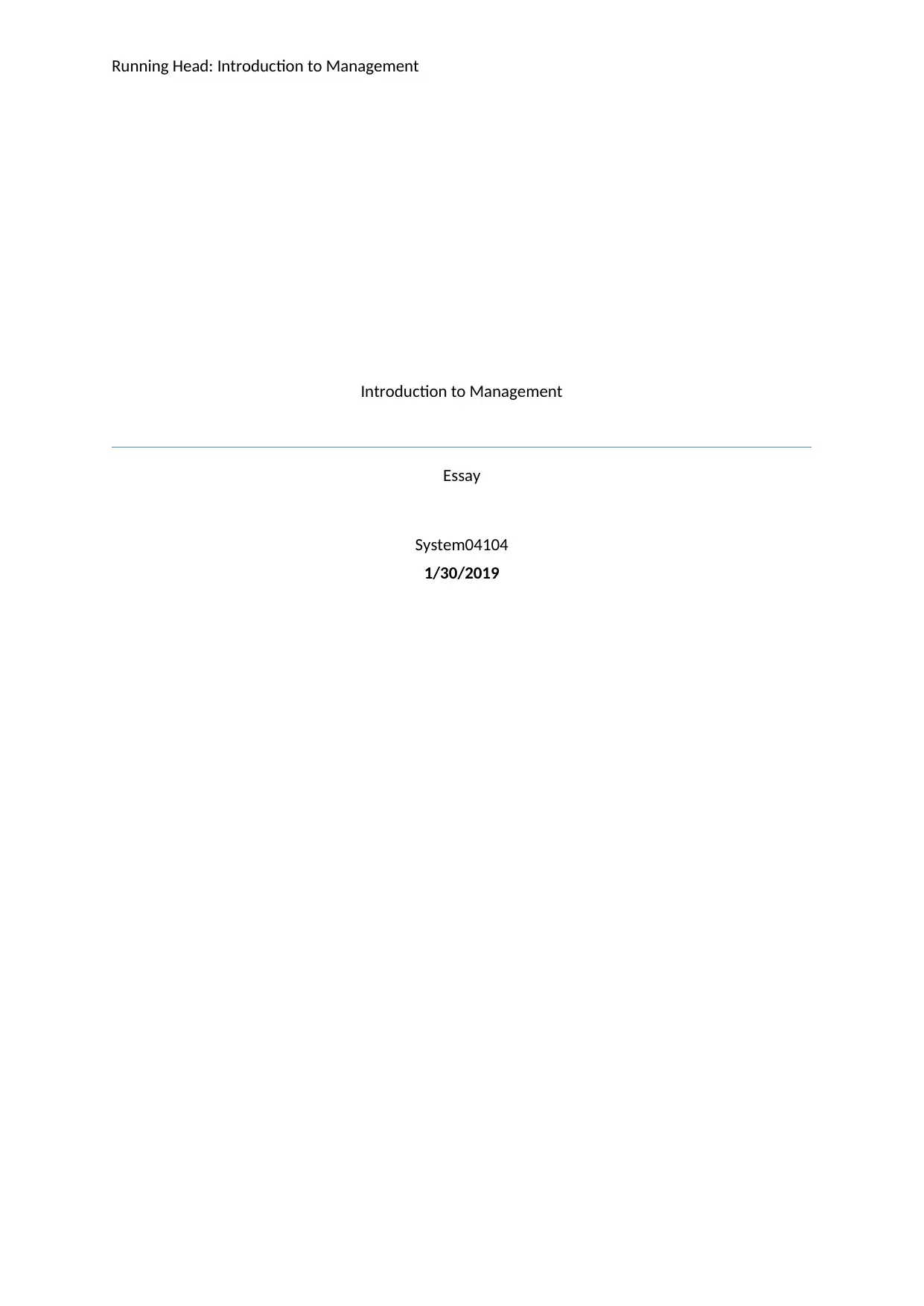
Running Head: Introduction to Management
Introduction to Management
Essay
System04104
1/30/2019
Introduction to Management
Essay
System04104
1/30/2019
Paraphrase This Document
Need a fresh take? Get an instant paraphrase of this document with our AI Paraphraser
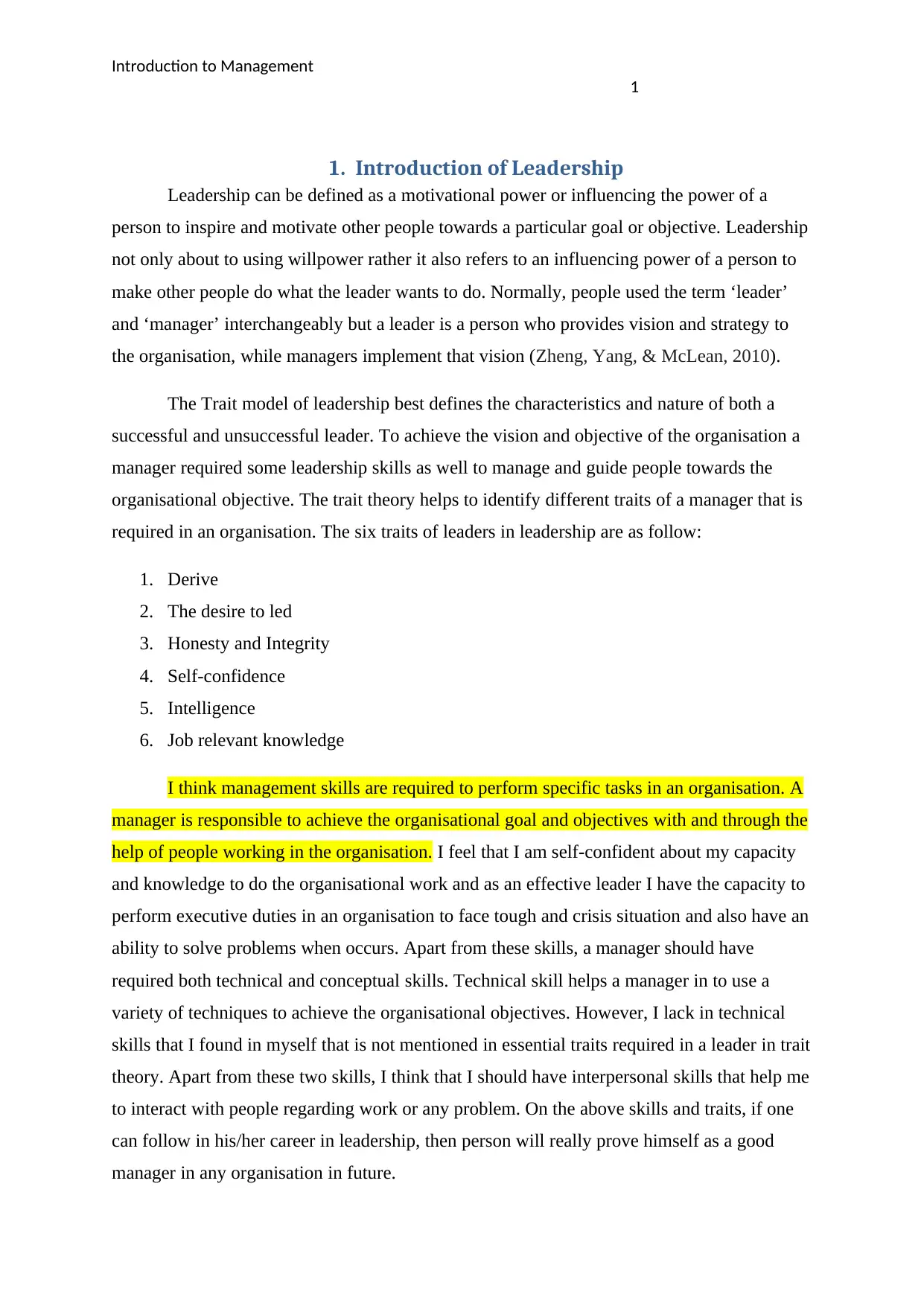
Introduction to Management
1
1. Introduction of Leadership
Leadership can be defined as a motivational power or influencing the power of a
person to inspire and motivate other people towards a particular goal or objective. Leadership
not only about to using willpower rather it also refers to an influencing power of a person to
make other people do what the leader wants to do. Normally, people used the term ‘leader’
and ‘manager’ interchangeably but a leader is a person who provides vision and strategy to
the organisation, while managers implement that vision (Zheng, Yang, & McLean, 2010).
The Trait model of leadership best defines the characteristics and nature of both a
successful and unsuccessful leader. To achieve the vision and objective of the organisation a
manager required some leadership skills as well to manage and guide people towards the
organisational objective. The trait theory helps to identify different traits of a manager that is
required in an organisation. The six traits of leaders in leadership are as follow:
1. Derive
2. The desire to led
3. Honesty and Integrity
4. Self-confidence
5. Intelligence
6. Job relevant knowledge
I think management skills are required to perform specific tasks in an organisation. A
manager is responsible to achieve the organisational goal and objectives with and through the
help of people working in the organisation. I feel that I am self-confident about my capacity
and knowledge to do the organisational work and as an effective leader I have the capacity to
perform executive duties in an organisation to face tough and crisis situation and also have an
ability to solve problems when occurs. Apart from these skills, a manager should have
required both technical and conceptual skills. Technical skill helps a manager in to use a
variety of techniques to achieve the organisational objectives. However, I lack in technical
skills that I found in myself that is not mentioned in essential traits required in a leader in trait
theory. Apart from these two skills, I think that I should have interpersonal skills that help me
to interact with people regarding work or any problem. On the above skills and traits, if one
can follow in his/her career in leadership, then person will really prove himself as a good
manager in any organisation in future.
1
1. Introduction of Leadership
Leadership can be defined as a motivational power or influencing the power of a
person to inspire and motivate other people towards a particular goal or objective. Leadership
not only about to using willpower rather it also refers to an influencing power of a person to
make other people do what the leader wants to do. Normally, people used the term ‘leader’
and ‘manager’ interchangeably but a leader is a person who provides vision and strategy to
the organisation, while managers implement that vision (Zheng, Yang, & McLean, 2010).
The Trait model of leadership best defines the characteristics and nature of both a
successful and unsuccessful leader. To achieve the vision and objective of the organisation a
manager required some leadership skills as well to manage and guide people towards the
organisational objective. The trait theory helps to identify different traits of a manager that is
required in an organisation. The six traits of leaders in leadership are as follow:
1. Derive
2. The desire to led
3. Honesty and Integrity
4. Self-confidence
5. Intelligence
6. Job relevant knowledge
I think management skills are required to perform specific tasks in an organisation. A
manager is responsible to achieve the organisational goal and objectives with and through the
help of people working in the organisation. I feel that I am self-confident about my capacity
and knowledge to do the organisational work and as an effective leader I have the capacity to
perform executive duties in an organisation to face tough and crisis situation and also have an
ability to solve problems when occurs. Apart from these skills, a manager should have
required both technical and conceptual skills. Technical skill helps a manager in to use a
variety of techniques to achieve the organisational objectives. However, I lack in technical
skills that I found in myself that is not mentioned in essential traits required in a leader in trait
theory. Apart from these two skills, I think that I should have interpersonal skills that help me
to interact with people regarding work or any problem. On the above skills and traits, if one
can follow in his/her career in leadership, then person will really prove himself as a good
manager in any organisation in future.
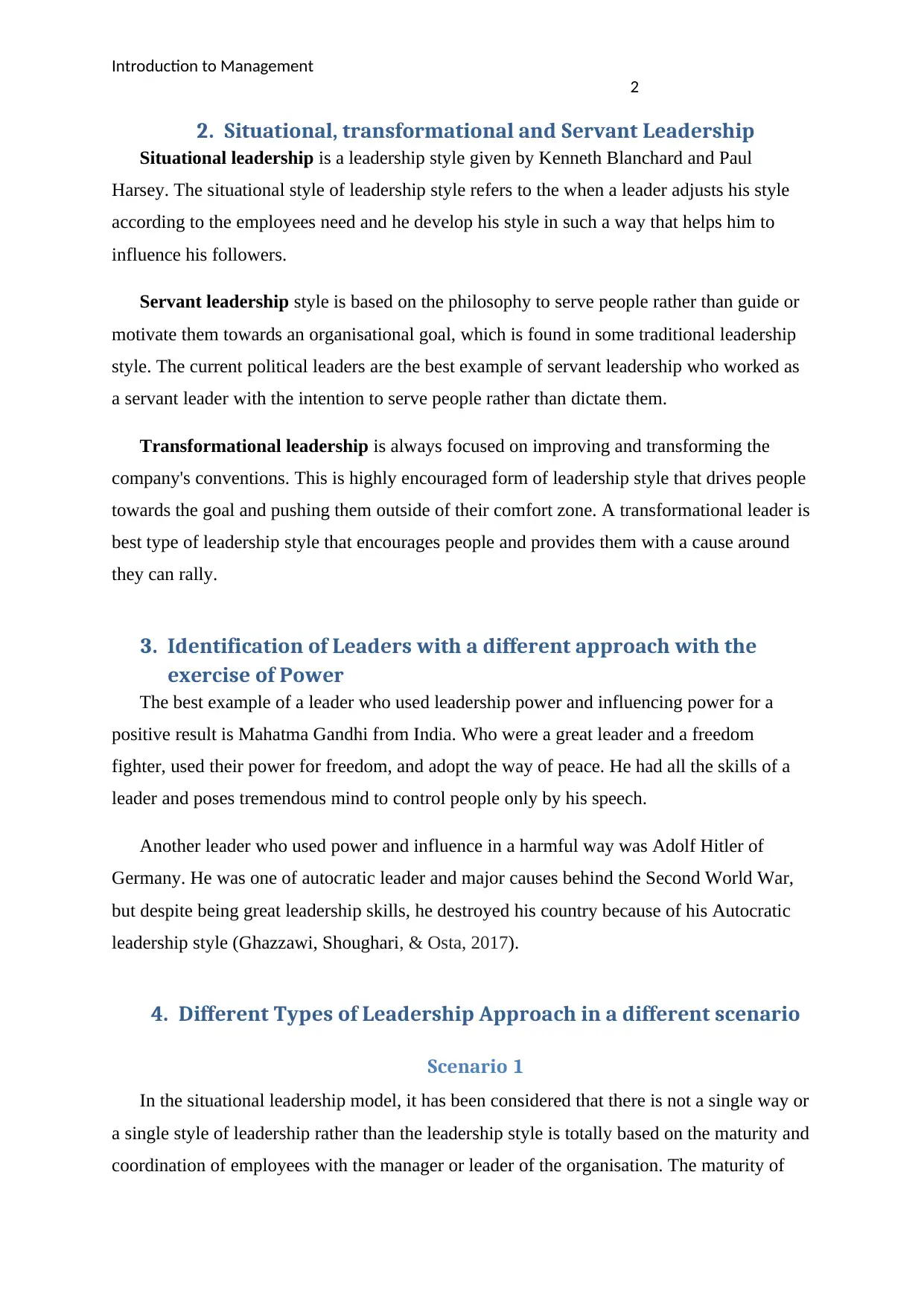
Introduction to Management
2
2. Situational, transformational and Servant Leadership
Situational leadership is a leadership style given by Kenneth Blanchard and Paul
Harsey. The situational style of leadership style refers to the when a leader adjusts his style
according to the employees need and he develop his style in such a way that helps him to
influence his followers.
Servant leadership style is based on the philosophy to serve people rather than guide or
motivate them towards an organisational goal, which is found in some traditional leadership
style. The current political leaders are the best example of servant leadership who worked as
a servant leader with the intention to serve people rather than dictate them.
Transformational leadership is always focused on improving and transforming the
company's conventions. This is highly encouraged form of leadership style that drives people
towards the goal and pushing them outside of their comfort zone. A transformational leader is
best type of leadership style that encourages people and provides them with a cause around
they can rally.
3. Identification of Leaders with a different approach with the
exercise of Power
The best example of a leader who used leadership power and influencing power for a
positive result is Mahatma Gandhi from India. Who were a great leader and a freedom
fighter, used their power for freedom, and adopt the way of peace. He had all the skills of a
leader and poses tremendous mind to control people only by his speech.
Another leader who used power and influence in a harmful way was Adolf Hitler of
Germany. He was one of autocratic leader and major causes behind the Second World War,
but despite being great leadership skills, he destroyed his country because of his Autocratic
leadership style (Ghazzawi, Shoughari, & Osta, 2017).
4. Different Types of Leadership Approach in a different scenario
Scenario 1
In the situational leadership model, it has been considered that there is not a single way or
a single style of leadership rather than the leadership style is totally based on the maturity and
coordination of employees with the manager or leader of the organisation. The maturity of
2
2. Situational, transformational and Servant Leadership
Situational leadership is a leadership style given by Kenneth Blanchard and Paul
Harsey. The situational style of leadership style refers to the when a leader adjusts his style
according to the employees need and he develop his style in such a way that helps him to
influence his followers.
Servant leadership style is based on the philosophy to serve people rather than guide or
motivate them towards an organisational goal, which is found in some traditional leadership
style. The current political leaders are the best example of servant leadership who worked as
a servant leader with the intention to serve people rather than dictate them.
Transformational leadership is always focused on improving and transforming the
company's conventions. This is highly encouraged form of leadership style that drives people
towards the goal and pushing them outside of their comfort zone. A transformational leader is
best type of leadership style that encourages people and provides them with a cause around
they can rally.
3. Identification of Leaders with a different approach with the
exercise of Power
The best example of a leader who used leadership power and influencing power for a
positive result is Mahatma Gandhi from India. Who were a great leader and a freedom
fighter, used their power for freedom, and adopt the way of peace. He had all the skills of a
leader and poses tremendous mind to control people only by his speech.
Another leader who used power and influence in a harmful way was Adolf Hitler of
Germany. He was one of autocratic leader and major causes behind the Second World War,
but despite being great leadership skills, he destroyed his country because of his Autocratic
leadership style (Ghazzawi, Shoughari, & Osta, 2017).
4. Different Types of Leadership Approach in a different scenario
Scenario 1
In the situational leadership model, it has been considered that there is not a single way or
a single style of leadership rather than the leadership style is totally based on the maturity and
coordination of employees with the manager or leader of the organisation. The maturity of
⊘ This is a preview!⊘
Do you want full access?
Subscribe today to unlock all pages.

Trusted by 1+ million students worldwide
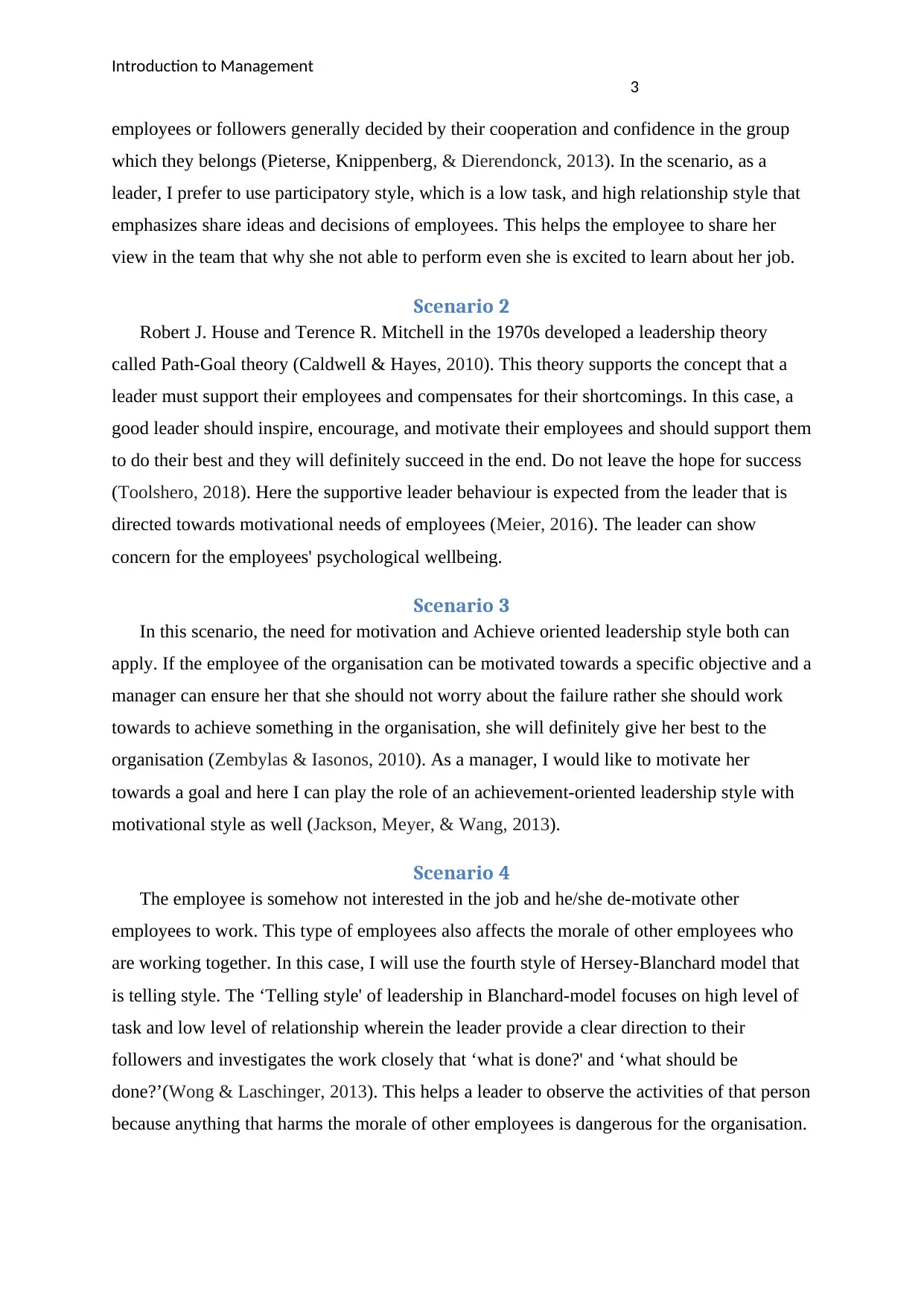
Introduction to Management
3
employees or followers generally decided by their cooperation and confidence in the group
which they belongs (Pieterse, Knippenberg, & Dierendonck, 2013). In the scenario, as a
leader, I prefer to use participatory style, which is a low task, and high relationship style that
emphasizes share ideas and decisions of employees. This helps the employee to share her
view in the team that why she not able to perform even she is excited to learn about her job.
Scenario 2
Robert J. House and Terence R. Mitchell in the 1970s developed a leadership theory
called Path-Goal theory (Caldwell & Hayes, 2010). This theory supports the concept that a
leader must support their employees and compensates for their shortcomings. In this case, a
good leader should inspire, encourage, and motivate their employees and should support them
to do their best and they will definitely succeed in the end. Do not leave the hope for success
(Toolshero, 2018). Here the supportive leader behaviour is expected from the leader that is
directed towards motivational needs of employees (Meier, 2016). The leader can show
concern for the employees' psychological wellbeing.
Scenario 3
In this scenario, the need for motivation and Achieve oriented leadership style both can
apply. If the employee of the organisation can be motivated towards a specific objective and a
manager can ensure her that she should not worry about the failure rather she should work
towards to achieve something in the organisation, she will definitely give her best to the
organisation (Zembylas & Iasonos, 2010). As a manager, I would like to motivate her
towards a goal and here I can play the role of an achievement-oriented leadership style with
motivational style as well (Jackson, Meyer, & Wang, 2013).
Scenario 4
The employee is somehow not interested in the job and he/she de-motivate other
employees to work. This type of employees also affects the morale of other employees who
are working together. In this case, I will use the fourth style of Hersey-Blanchard model that
is telling style. The ‘Telling style' of leadership in Blanchard-model focuses on high level of
task and low level of relationship wherein the leader provide a clear direction to their
followers and investigates the work closely that ‘what is done?' and ‘what should be
done?’(Wong & Laschinger, 2013). This helps a leader to observe the activities of that person
because anything that harms the morale of other employees is dangerous for the organisation.
3
employees or followers generally decided by their cooperation and confidence in the group
which they belongs (Pieterse, Knippenberg, & Dierendonck, 2013). In the scenario, as a
leader, I prefer to use participatory style, which is a low task, and high relationship style that
emphasizes share ideas and decisions of employees. This helps the employee to share her
view in the team that why she not able to perform even she is excited to learn about her job.
Scenario 2
Robert J. House and Terence R. Mitchell in the 1970s developed a leadership theory
called Path-Goal theory (Caldwell & Hayes, 2010). This theory supports the concept that a
leader must support their employees and compensates for their shortcomings. In this case, a
good leader should inspire, encourage, and motivate their employees and should support them
to do their best and they will definitely succeed in the end. Do not leave the hope for success
(Toolshero, 2018). Here the supportive leader behaviour is expected from the leader that is
directed towards motivational needs of employees (Meier, 2016). The leader can show
concern for the employees' psychological wellbeing.
Scenario 3
In this scenario, the need for motivation and Achieve oriented leadership style both can
apply. If the employee of the organisation can be motivated towards a specific objective and a
manager can ensure her that she should not worry about the failure rather she should work
towards to achieve something in the organisation, she will definitely give her best to the
organisation (Zembylas & Iasonos, 2010). As a manager, I would like to motivate her
towards a goal and here I can play the role of an achievement-oriented leadership style with
motivational style as well (Jackson, Meyer, & Wang, 2013).
Scenario 4
The employee is somehow not interested in the job and he/she de-motivate other
employees to work. This type of employees also affects the morale of other employees who
are working together. In this case, I will use the fourth style of Hersey-Blanchard model that
is telling style. The ‘Telling style' of leadership in Blanchard-model focuses on high level of
task and low level of relationship wherein the leader provide a clear direction to their
followers and investigates the work closely that ‘what is done?' and ‘what should be
done?’(Wong & Laschinger, 2013). This helps a leader to observe the activities of that person
because anything that harms the morale of other employees is dangerous for the organisation.
Paraphrase This Document
Need a fresh take? Get an instant paraphrase of this document with our AI Paraphraser
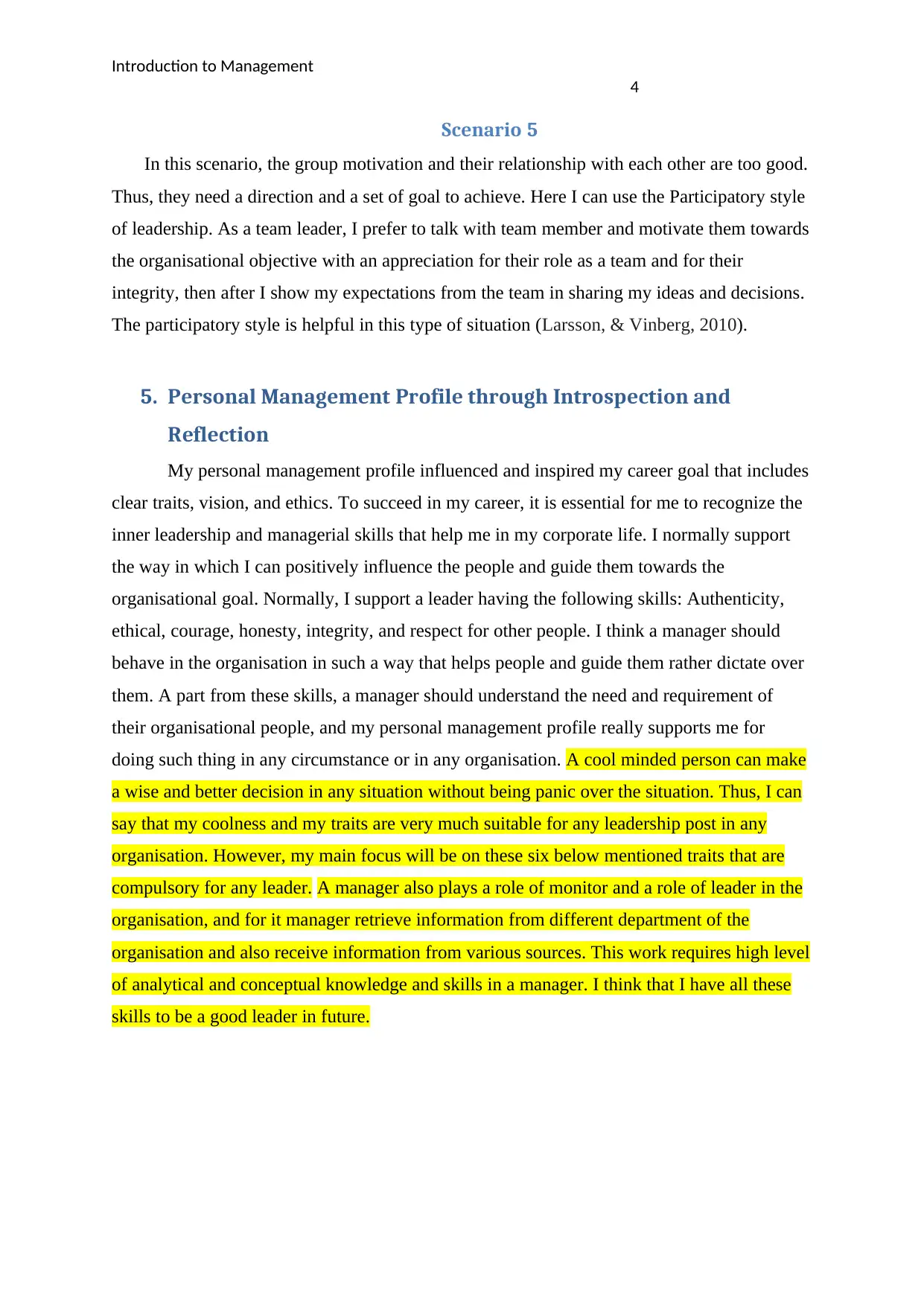
Introduction to Management
4
Scenario 5
In this scenario, the group motivation and their relationship with each other are too good.
Thus, they need a direction and a set of goal to achieve. Here I can use the Participatory style
of leadership. As a team leader, I prefer to talk with team member and motivate them towards
the organisational objective with an appreciation for their role as a team and for their
integrity, then after I show my expectations from the team in sharing my ideas and decisions.
The participatory style is helpful in this type of situation (Larsson, & Vinberg, 2010).
5. Personal Management Profile through Introspection and
Reflection
My personal management profile influenced and inspired my career goal that includes
clear traits, vision, and ethics. To succeed in my career, it is essential for me to recognize the
inner leadership and managerial skills that help me in my corporate life. I normally support
the way in which I can positively influence the people and guide them towards the
organisational goal. Normally, I support a leader having the following skills: Authenticity,
ethical, courage, honesty, integrity, and respect for other people. I think a manager should
behave in the organisation in such a way that helps people and guide them rather dictate over
them. A part from these skills, a manager should understand the need and requirement of
their organisational people, and my personal management profile really supports me for
doing such thing in any circumstance or in any organisation. A cool minded person can make
a wise and better decision in any situation without being panic over the situation. Thus, I can
say that my coolness and my traits are very much suitable for any leadership post in any
organisation. However, my main focus will be on these six below mentioned traits that are
compulsory for any leader. A manager also plays a role of monitor and a role of leader in the
organisation, and for it manager retrieve information from different department of the
organisation and also receive information from various sources. This work requires high level
of analytical and conceptual knowledge and skills in a manager. I think that I have all these
skills to be a good leader in future.
4
Scenario 5
In this scenario, the group motivation and their relationship with each other are too good.
Thus, they need a direction and a set of goal to achieve. Here I can use the Participatory style
of leadership. As a team leader, I prefer to talk with team member and motivate them towards
the organisational objective with an appreciation for their role as a team and for their
integrity, then after I show my expectations from the team in sharing my ideas and decisions.
The participatory style is helpful in this type of situation (Larsson, & Vinberg, 2010).
5. Personal Management Profile through Introspection and
Reflection
My personal management profile influenced and inspired my career goal that includes
clear traits, vision, and ethics. To succeed in my career, it is essential for me to recognize the
inner leadership and managerial skills that help me in my corporate life. I normally support
the way in which I can positively influence the people and guide them towards the
organisational goal. Normally, I support a leader having the following skills: Authenticity,
ethical, courage, honesty, integrity, and respect for other people. I think a manager should
behave in the organisation in such a way that helps people and guide them rather dictate over
them. A part from these skills, a manager should understand the need and requirement of
their organisational people, and my personal management profile really supports me for
doing such thing in any circumstance or in any organisation. A cool minded person can make
a wise and better decision in any situation without being panic over the situation. Thus, I can
say that my coolness and my traits are very much suitable for any leadership post in any
organisation. However, my main focus will be on these six below mentioned traits that are
compulsory for any leader. A manager also plays a role of monitor and a role of leader in the
organisation, and for it manager retrieve information from different department of the
organisation and also receive information from various sources. This work requires high level
of analytical and conceptual knowledge and skills in a manager. I think that I have all these
skills to be a good leader in future.
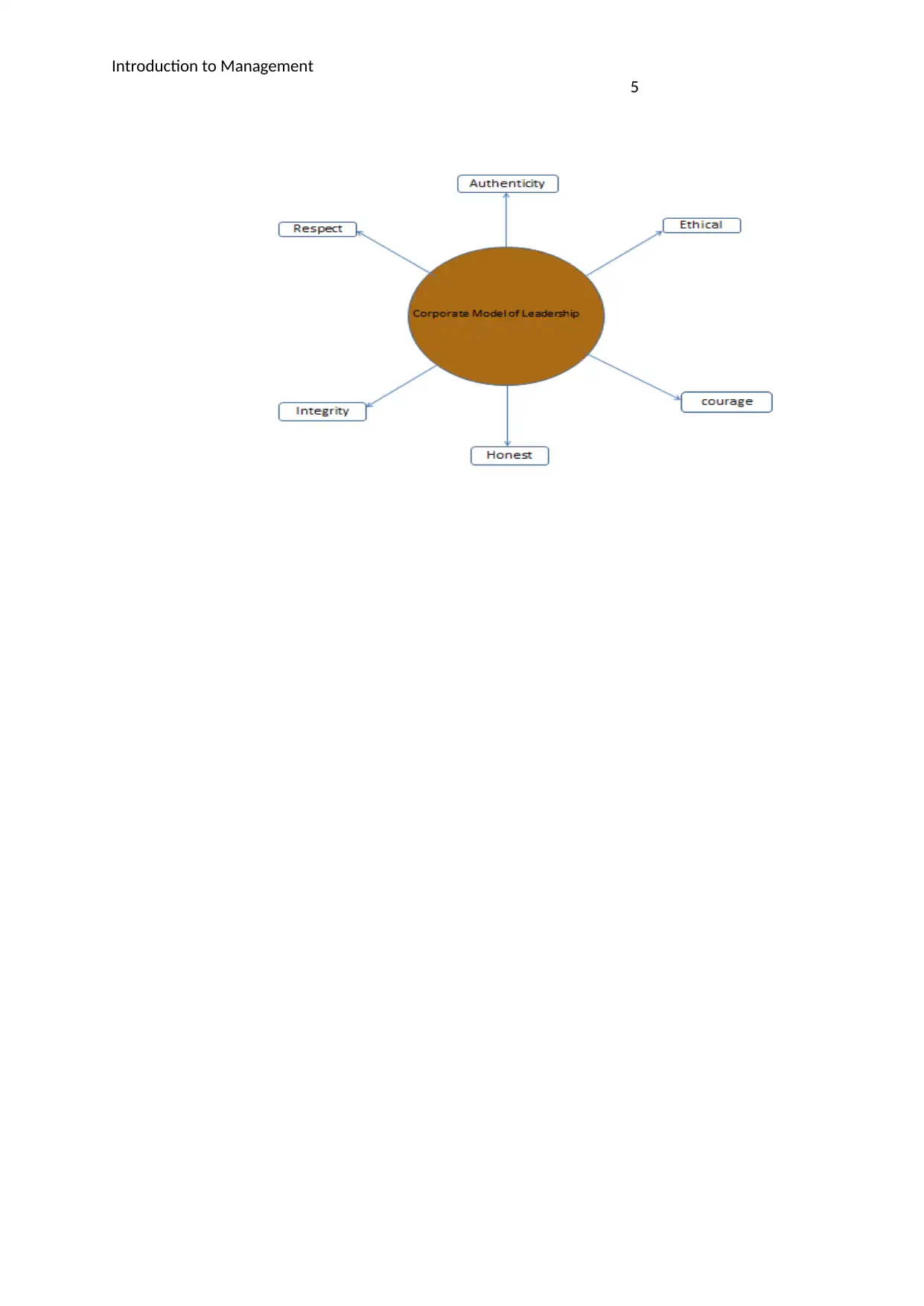
Introduction to Management
5
5
⊘ This is a preview!⊘
Do you want full access?
Subscribe today to unlock all pages.

Trusted by 1+ million students worldwide
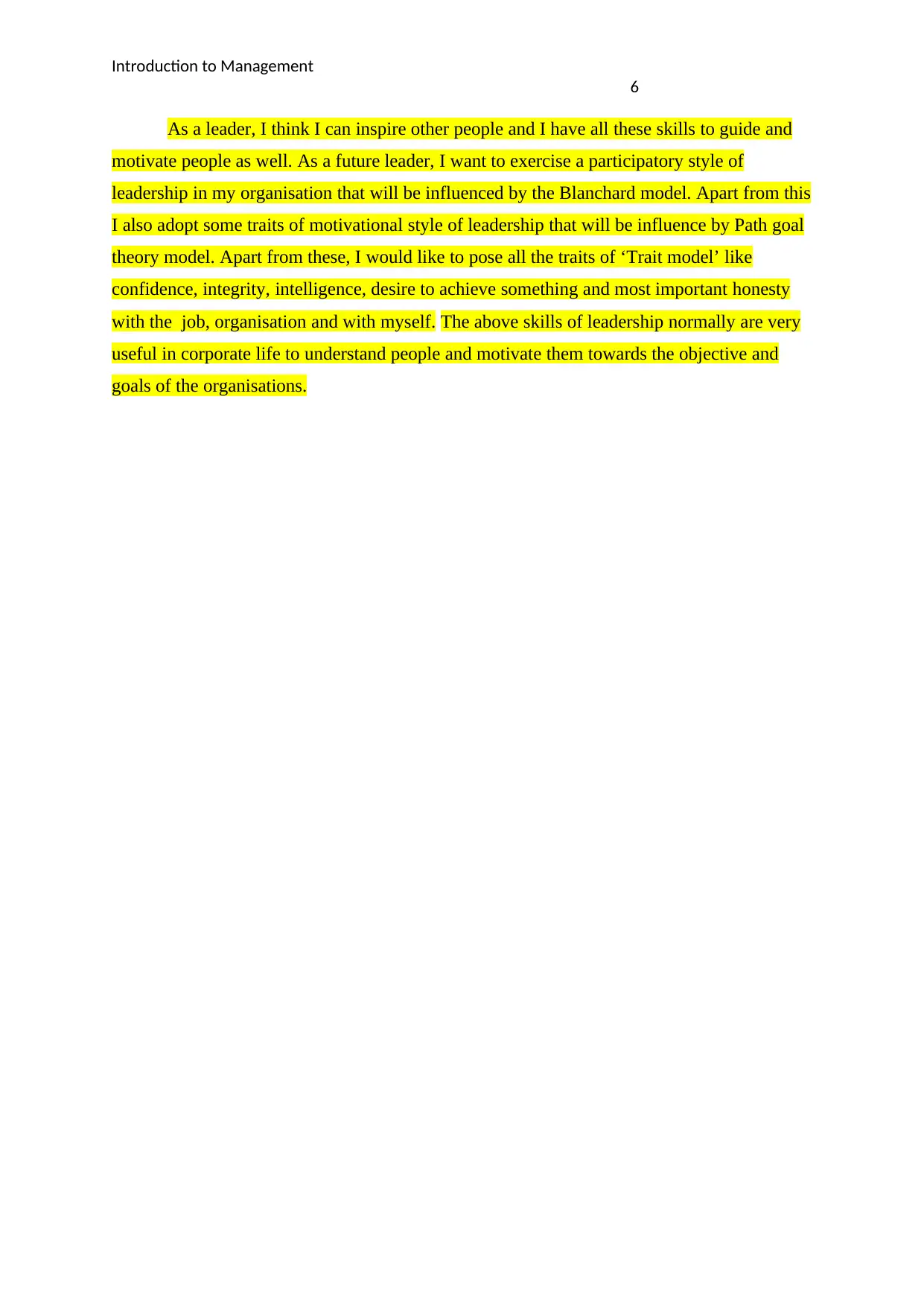
Introduction to Management
6
As a leader, I think I can inspire other people and I have all these skills to guide and
motivate people as well. As a future leader, I want to exercise a participatory style of
leadership in my organisation that will be influenced by the Blanchard model. Apart from this
I also adopt some traits of motivational style of leadership that will be influence by Path goal
theory model. Apart from these, I would like to pose all the traits of ‘Trait model’ like
confidence, integrity, intelligence, desire to achieve something and most important honesty
with the job, organisation and with myself. The above skills of leadership normally are very
useful in corporate life to understand people and motivate them towards the objective and
goals of the organisations.
6
As a leader, I think I can inspire other people and I have all these skills to guide and
motivate people as well. As a future leader, I want to exercise a participatory style of
leadership in my organisation that will be influenced by the Blanchard model. Apart from this
I also adopt some traits of motivational style of leadership that will be influence by Path goal
theory model. Apart from these, I would like to pose all the traits of ‘Trait model’ like
confidence, integrity, intelligence, desire to achieve something and most important honesty
with the job, organisation and with myself. The above skills of leadership normally are very
useful in corporate life to understand people and motivate them towards the objective and
goals of the organisations.
Paraphrase This Document
Need a fresh take? Get an instant paraphrase of this document with our AI Paraphraser
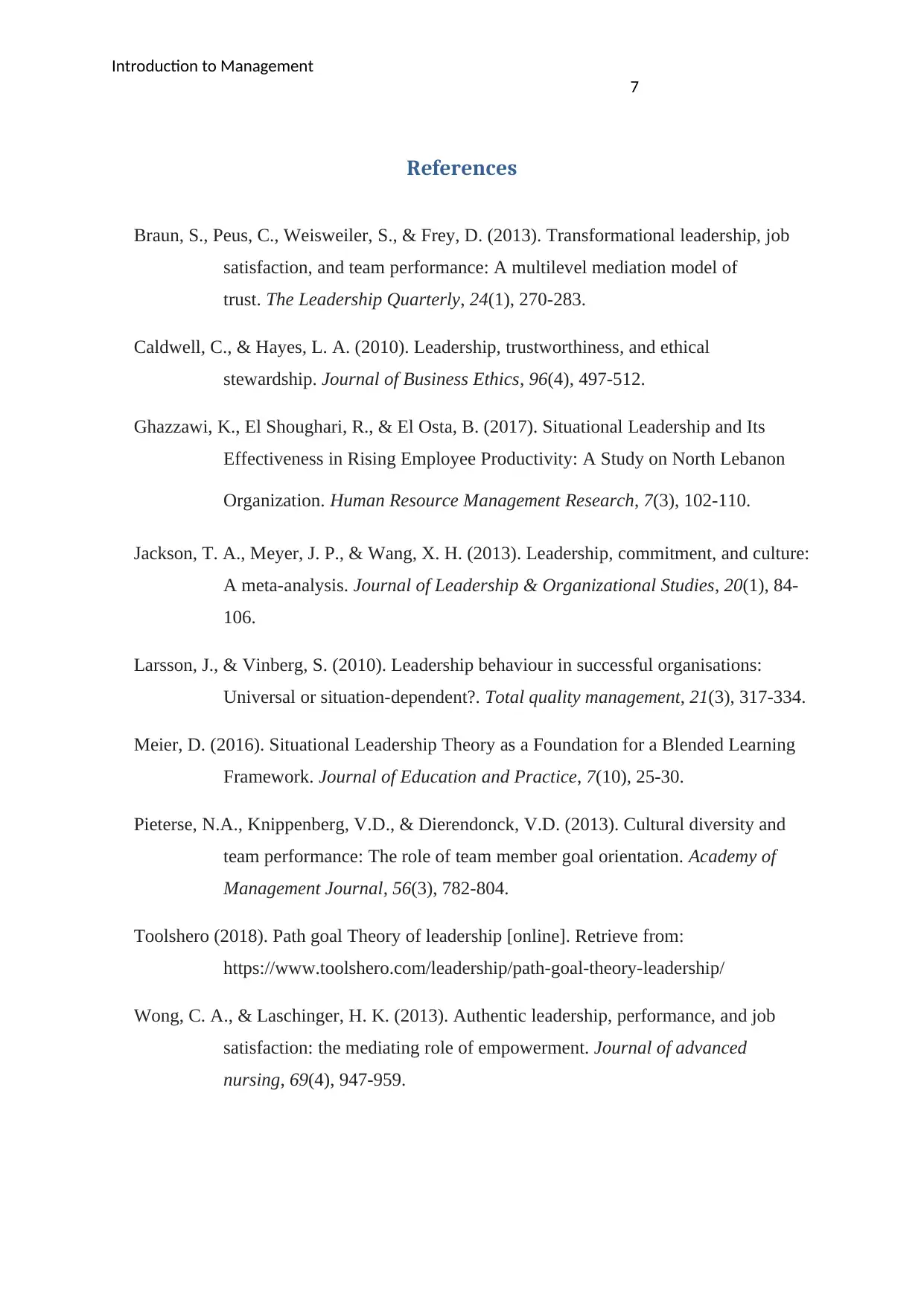
Introduction to Management
7
References
Braun, S., Peus, C., Weisweiler, S., & Frey, D. (2013). Transformational leadership, job
satisfaction, and team performance: A multilevel mediation model of
trust. The Leadership Quarterly, 24(1), 270-283.
Caldwell, C., & Hayes, L. A. (2010). Leadership, trustworthiness, and ethical
stewardship. Journal of Business Ethics, 96(4), 497-512.
Ghazzawi, K., El Shoughari, R., & El Osta, B. (2017). Situational Leadership and Its
Effectiveness in Rising Employee Productivity: A Study on North Lebanon
Organization. Human Resource Management Research, 7(3), 102-110.
Jackson, T. A., Meyer, J. P., & Wang, X. H. (2013). Leadership, commitment, and culture:
A meta-analysis. Journal of Leadership & Organizational Studies, 20(1), 84-
106.
Larsson, J., & Vinberg, S. (2010). Leadership behaviour in successful organisations:
Universal or situation-dependent?. Total quality management, 21(3), 317-334.
Meier, D. (2016). Situational Leadership Theory as a Foundation for a Blended Learning
Framework. Journal of Education and Practice, 7(10), 25-30.
Pieterse, N.A., Knippenberg, V.D., & Dierendonck, V.D. (2013). Cultural diversity and
team performance: The role of team member goal orientation. Academy of
Management Journal, 56(3), 782-804.
Toolshero (2018). Path goal Theory of leadership [online]. Retrieve from:
https://www.toolshero.com/leadership/path-goal-theory-leadership/
Wong, C. A., & Laschinger, H. K. (2013). Authentic leadership, performance, and job
satisfaction: the mediating role of empowerment. Journal of advanced
nursing, 69(4), 947-959.
7
References
Braun, S., Peus, C., Weisweiler, S., & Frey, D. (2013). Transformational leadership, job
satisfaction, and team performance: A multilevel mediation model of
trust. The Leadership Quarterly, 24(1), 270-283.
Caldwell, C., & Hayes, L. A. (2010). Leadership, trustworthiness, and ethical
stewardship. Journal of Business Ethics, 96(4), 497-512.
Ghazzawi, K., El Shoughari, R., & El Osta, B. (2017). Situational Leadership and Its
Effectiveness in Rising Employee Productivity: A Study on North Lebanon
Organization. Human Resource Management Research, 7(3), 102-110.
Jackson, T. A., Meyer, J. P., & Wang, X. H. (2013). Leadership, commitment, and culture:
A meta-analysis. Journal of Leadership & Organizational Studies, 20(1), 84-
106.
Larsson, J., & Vinberg, S. (2010). Leadership behaviour in successful organisations:
Universal or situation-dependent?. Total quality management, 21(3), 317-334.
Meier, D. (2016). Situational Leadership Theory as a Foundation for a Blended Learning
Framework. Journal of Education and Practice, 7(10), 25-30.
Pieterse, N.A., Knippenberg, V.D., & Dierendonck, V.D. (2013). Cultural diversity and
team performance: The role of team member goal orientation. Academy of
Management Journal, 56(3), 782-804.
Toolshero (2018). Path goal Theory of leadership [online]. Retrieve from:
https://www.toolshero.com/leadership/path-goal-theory-leadership/
Wong, C. A., & Laschinger, H. K. (2013). Authentic leadership, performance, and job
satisfaction: the mediating role of empowerment. Journal of advanced
nursing, 69(4), 947-959.
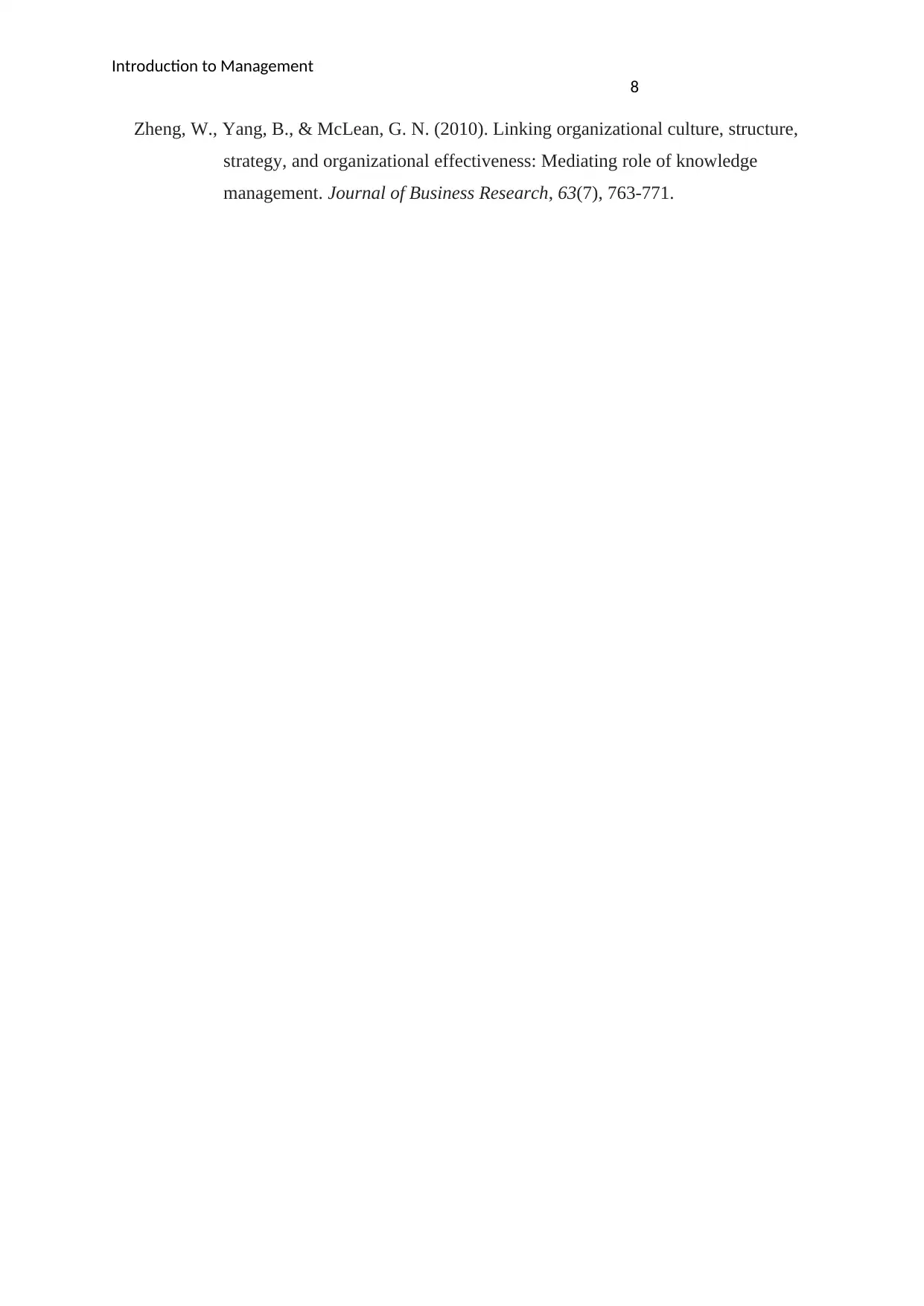
Introduction to Management
8
Zheng, W., Yang, B., & McLean, G. N. (2010). Linking organizational culture, structure,
strategy, and organizational effectiveness: Mediating role of knowledge
management. Journal of Business Research, 63(7), 763-771.
8
Zheng, W., Yang, B., & McLean, G. N. (2010). Linking organizational culture, structure,
strategy, and organizational effectiveness: Mediating role of knowledge
management. Journal of Business Research, 63(7), 763-771.
⊘ This is a preview!⊘
Do you want full access?
Subscribe today to unlock all pages.

Trusted by 1+ million students worldwide
1 out of 9
Related Documents
Your All-in-One AI-Powered Toolkit for Academic Success.
+13062052269
info@desklib.com
Available 24*7 on WhatsApp / Email
![[object Object]](/_next/static/media/star-bottom.7253800d.svg)
Unlock your academic potential
Copyright © 2020–2025 A2Z Services. All Rights Reserved. Developed and managed by ZUCOL.





